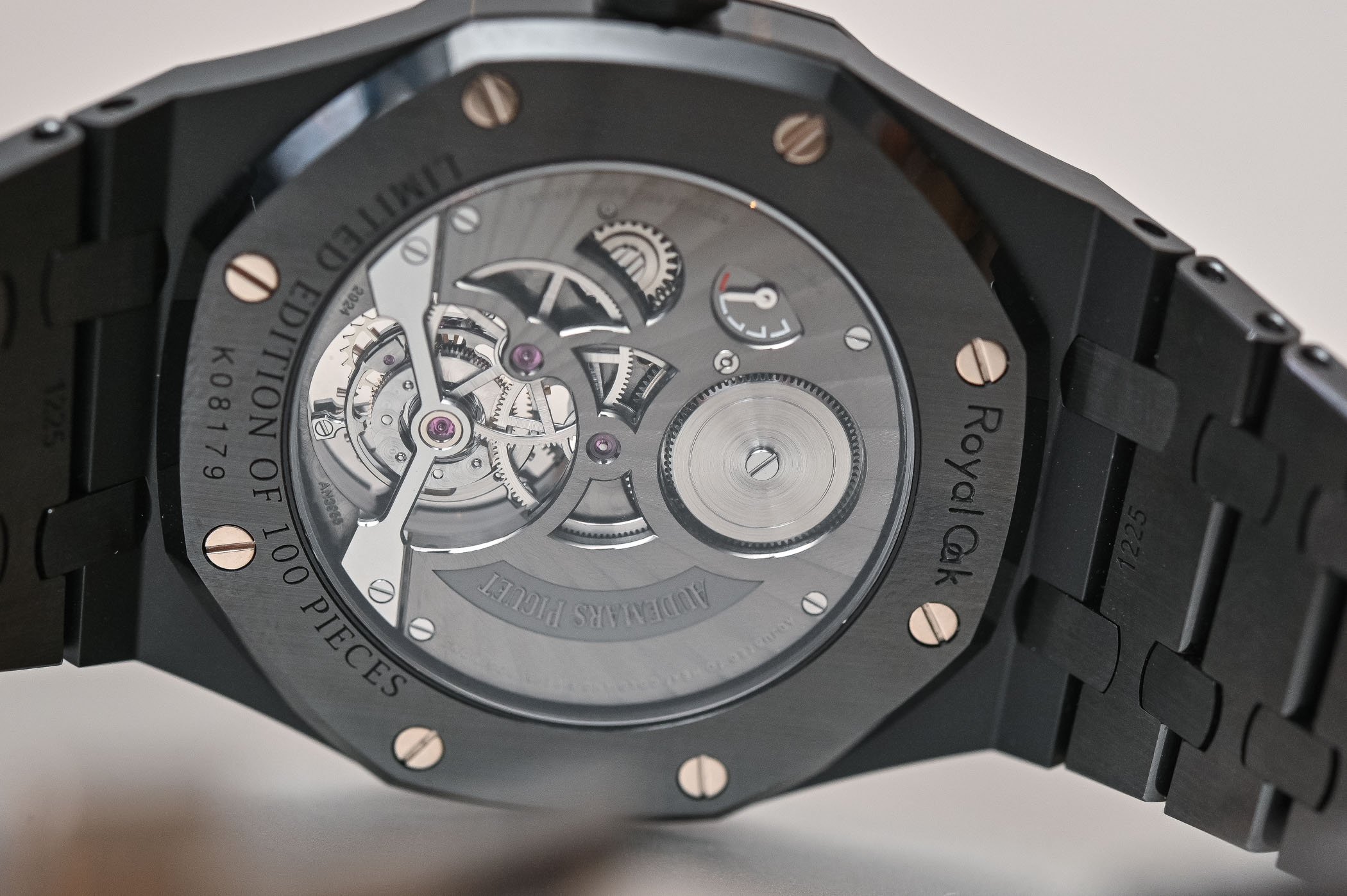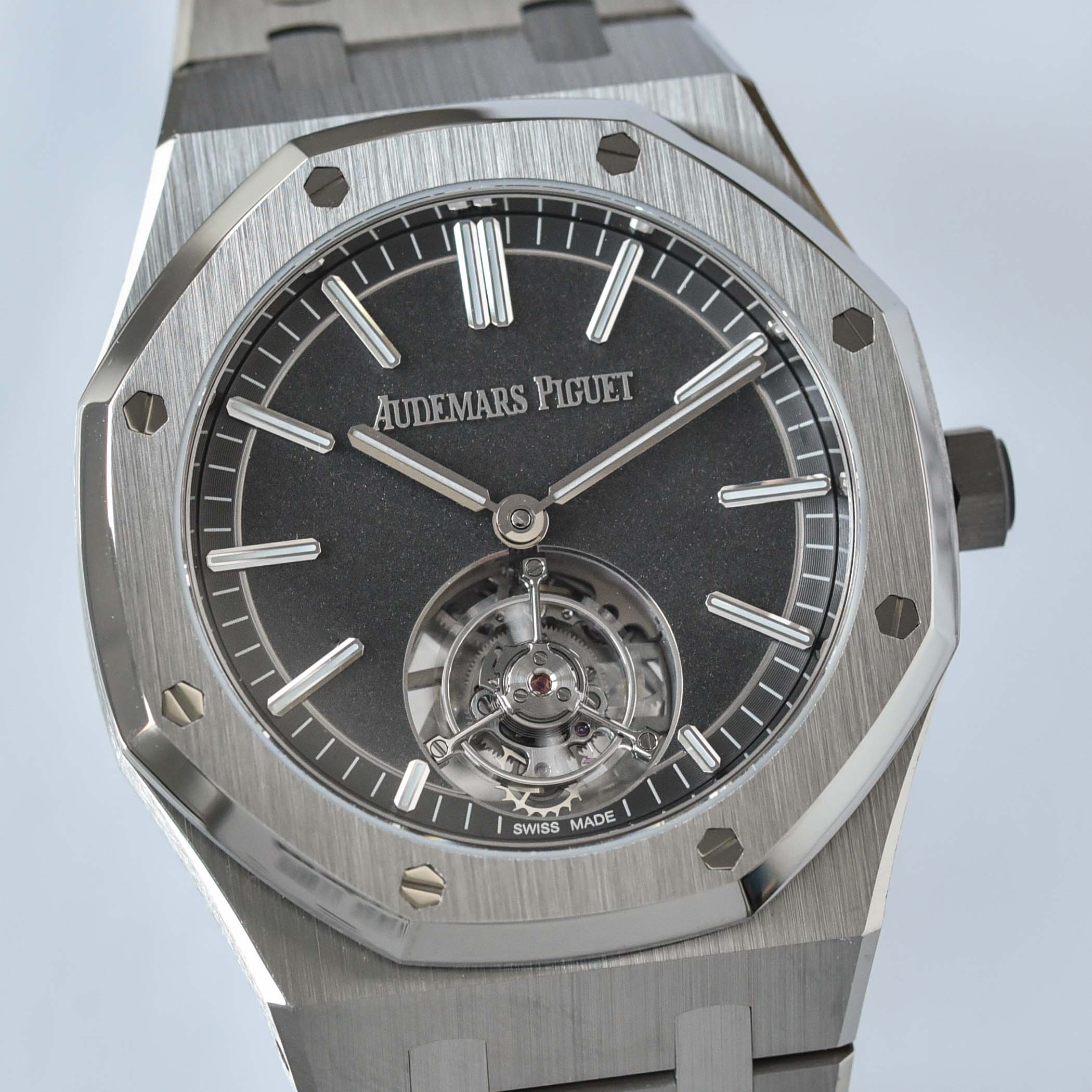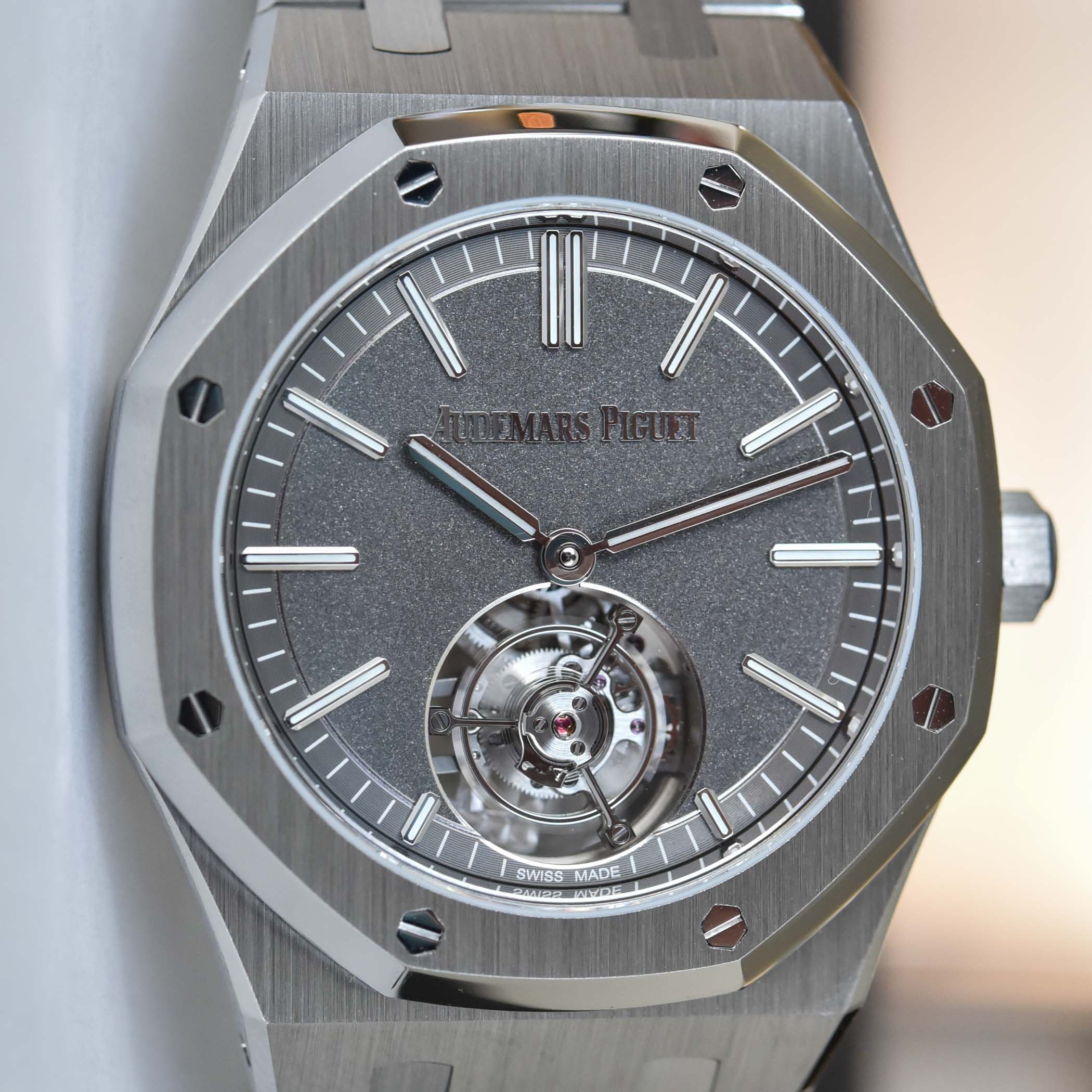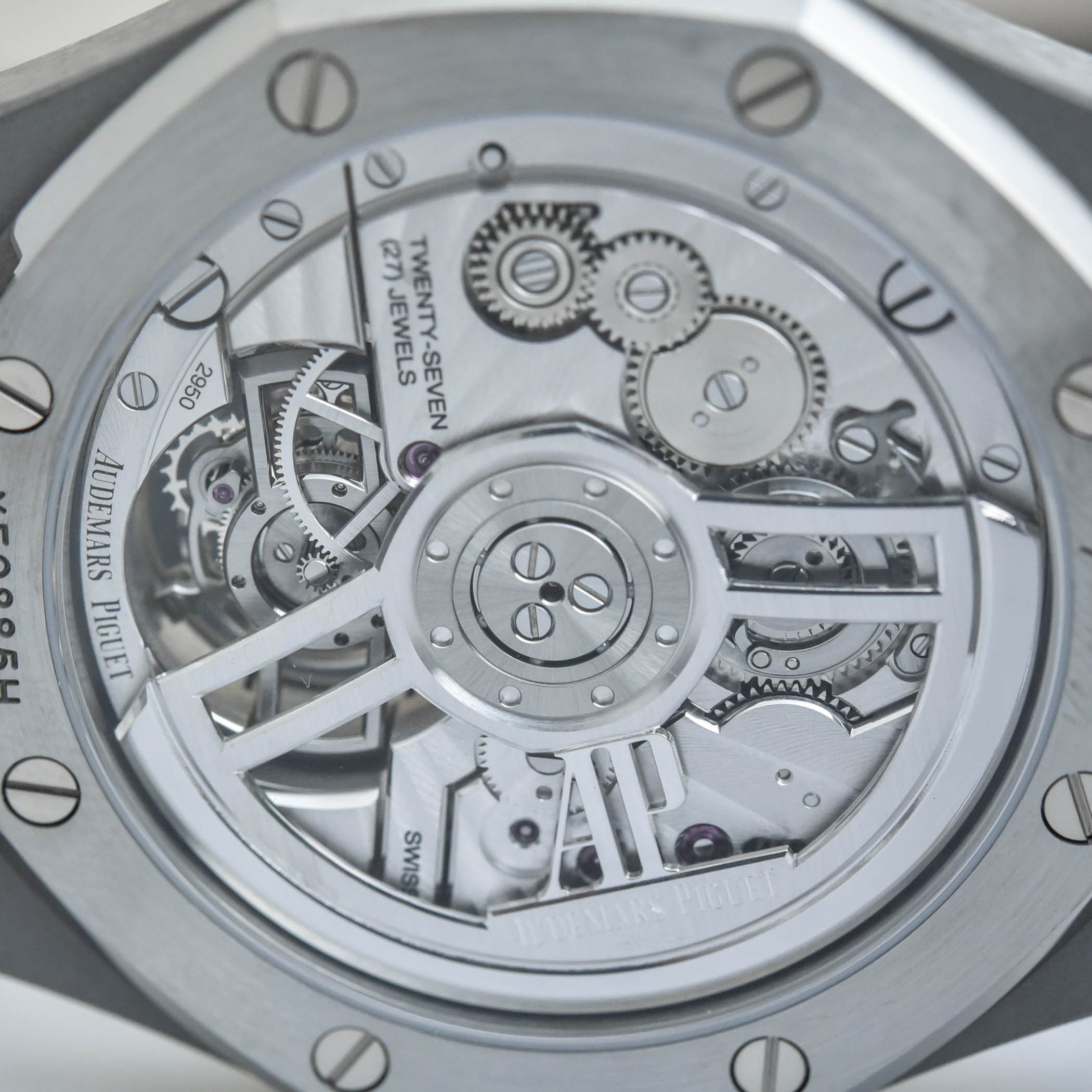The Surprising Titanium Audemars Piguet Royal Oak Selfwinding Flying Tourbillon
A new movement for the RO, as well as an unprecedented material/dial combination.

The Audemars Piguet Royal Oak, in addition to being one of the most emblematic watches on the market, the watch that created the luxury sports watch category and one of the hottest pieces currently for sale, has hosted a variety of complications in its complex case. The tourbillon is no stranger to the RO but has always been sort of a rara avis in this watch. About a week ago, Audemars Piguet introduced the Royal Oak Selfwinding Flying Tourbillon, with a movement never used in this collection, and a more contemporary approach. Among the three versions presented, one caught our attention. There was no steel case or blue guilloché dial here, but instead an unprecedented titanium case and sandblasted dial. Let’s have a closer look at this surprising reference 26530TI.
Background
Introduced in 1972, the Royal Oak inaugurated an entirely new concept: the luxury sports watch with an integrated bracelet. A robust and water-resistant steel case, a delicate extra-thin movement, a refined guilloché dial and a casual overall style… Gerald Genta’s creation broke the rules and created what’s today AP’s largest success and the market’s most coveted category of watches.

Originally equipped with an automatic time-and-date movement, it took a while for Audemars Piguet to include a tourbillon on its superstar watch. In fact, the tourbillon has not often been integrated into the original case of the Royal Oak and remains, even today, quite rare. The very first time this anti-gravity regulating organ was used in the RO was as a celebration of the 25th anniversary of the model, in 1997, with the reference 25831, a highly limited watch produced in very low quantities.

The Royal Oak Automatic Tourbillon 1972-1997 was a surprising watch on many levels. It was produced in very low quantities, with only 25 examples in steel (25831ST), 5 examples in yellow gold (25831BA), 5 examples in pink gold (25831OR), 5 examples in platinum (25831PT) and 1 example combining white and pink gold (25831RC). It was, until very recently, the only Royal Oak tourbillon fitted with a self-winding movement. This thin 40mm watch was also equipped with a surprising movement since the crown wasn’t located at 3 o’clock, but integrated into the caseback. The display was also original, with off-centred minutes and hours, a power reserve indicator and a date counter, all place on a finely guilloché “tapisserie” dial. The tourbillon at 6 o’clock was framed by an octagonal part, reminiscent of the iconic bezel.

The other important date to remember when it comes to a RO tourbillon is 2012. As part of the 40th-anniversary models introduced by Audemars Piguet was a watch that is still in the collection today: the Royal Oak Tourbillon Extra-Thin, with its slender hand-wound calibre and classic RO look.

Until now, this Royal Oak Tourbillon Extra-Thin was the only option for those who wanted a tourbillon-only RO watch. This year, Audemars Piguet adds a new watch to the collection with a slightly more casual, more robust and more daily-wear oriented spirit.
The Titanium Royal Oak Selfwinding Flying Tourbillon
This new model is launched in three different materials and colours. First is a classic stainless steel model with a smoked blue dial. The second model, more luxurious and opulent, is cased in 18k rose gold and features a smoked grey dial. Both are fitted with a guilloché dial and executed with a “Tapisserie Evolutive” pattern, which radiates from the centre of the tourbillon – a motif that was first used on the Royal Oak Tourbillon Extra-Thin and introduced in 2018.
There is a third model in this new sub-collection, a model that looks rather special and is made in a material that isn’t often used by Audemars Piguet – at least, a material that is mostly reserved to limited edition watches. And this is the model we chose for this hands-on article, the Royal Oak Selfwinding Flying Tourbillon Titanium 26530TI.
As mentioned, titanium isn’t often employed by Audemars Piguet in its Royal Oak collection – at least, not in the permanent collection. Stainless steel, the material first used in 1972, is the norm, together with precious metals and innovative ceramic compounds. Titanium has been seen in limited editions of the Royal Oak, like the superb Royal Oak Jumbo Extra-Thin 15202IP of 2018 combined with platinum elements (bezel and centre links). It is also used in the Royal Oak Selfwinding Perpetual Calendar Ultra-Thin, but once again, we’re talking about a very exclusive model.
So this year, for its new Royal Oak Selfwinding Flying Tourbillon, Audemars Piguet will offer a grade 5 titanium model in the permanent collection. And that’s not the only novelty here, as we’ll see later. The movement and dial are also unprecedented. But back to the case. In terms of proportions, AP remains classic, with a 41mm diameter. All the elements are, in terms of design, faithful to the rest of the collection, with the octagonal bezel and its eight gold screws, the alternation of brushed surfaces and polished accents, the hexagonal crown and, of course, an integrated bracelet (also in titanium).
Compared to the hand-wound Tourbillon Extra-Thin, the thickness remains fairly pleasant. Integrating a self-winding movement only added 1.4mm to the height of the case; this new model has a thickness of 10.4mm while the hand-wound version has 9mm. All in all, it doesn’t drastically change the feeling on the wrist. What does change the watch is the use of lightweight titanium. While a Royal Oak Selfwinding 15500ST in steel, a watch with exactly the same dimensions (41mm x 10.40mm), is a substantial piece on the wrist, this new Royal Oak Selfwinding Flying Tourbillon benefits from this material to be lighter and more comfortable – but still with enough weight to have that desired feeling of luxury and robustness.
The combination of this robust material, the slightly lighter but thicker case, the use of an automatic movement… All of that gives this new model a less precious, less delicate feeling on the wrist than the Tourbillon Extra-Thin. It is a more “daily-oriented” vision of the Royal Oak Tourbillon.
The other unusual and striking part on this new model, in addition to its titanium case/bracelet, is the dial. While you’d expect a Royal Oak to have a tapisserie pattern, which is the case for the steel and gold versions, the titanium version comes with something we’ve never seen before. Sleek, monochromatic, textured… and in fact, a great match with this full-metal attire.
For this version of the Royal Oak Selfwinding Flying Tourbillon Titanium, Audemars Piguet has opted for a slate-coloured dial with a sandblasted finishing in the centre, while the chapter ring is adorned with a snailed pattern. And while it certainly is a great departure from the iconic Tapisserie pattern, the result is absolutely stunning in the metal. Modern and discreet, it plays with the light and changes depending on the angle. The tourbillon, in a large aperture at 6 o’clock, is also highlighted by the sleek surroundings. Other than this new colour/texture, the elements of the dial are classic, with rounded baton hands and applied indexes, both filled with luminous material.
One detail to note is the presence of an applied Audemars Piguet logo at 12 o’clock, resulting from a complex 3D printing process called galvanic growth. Executed in 24k gold, each letter is connected with thin links almost invisible to the eye. The signature is then fixed on the dial by hand with minuscule legs. This technique was first used in Code 11.59 and now finds its way onto the dial of the Royal Oak.
Finally, there’s the movement, the in-house Calibre 2950. This movement is new to the Royal Oak but not new to Audemars Piguet, as it debuted in 2019 in the Code 11.59 Selfwinding Flying Tourbillon. Large, robustly built and automatic, it was also one of the first flying tourbillons of the brand – which only started to use it in 2018, in this Royal Oak Concept watch. On the contrary to a traditional tourbillon, held in place by a bridge on both sides, a flying tourbillon is cantilevered from the lower side of the movement and dial-side appears to float due to the absence of a bridge – leaving an unimpeded view of its rotations.
The calibre 2950 is a modern movement, with a 30.9mm diameter that fills the case nicely. It has a comfortable power reserve of 65 hours. The decoration, executed in the traditional Haute Horlogerie style, is specific to the Royal Oak and differs from Code 11.59, where the Geneva stripes are not radiating but vertical. The rotor, visible through the caseback, is openworked and finished with multiple inward angles, as well as a discreet evocation of the iconic octagon.
Availability & Price
The Audemars Piguet Royal Oak Selfwinding Flying Tourbillon in Titanium (reference 26530TI.OO.1220TI.01) is now available from boutiques and retailers and offered in the permanent collection, without limitation of production. It is priced at CHF 133,000.
More details at www.audemarspiguet.com.


















1 response
Looks superb in those photos, particularly the one on the wrist. A rare occasion where the tourbillon contributes positively to the look.
Wish I could afford it, sincerely.